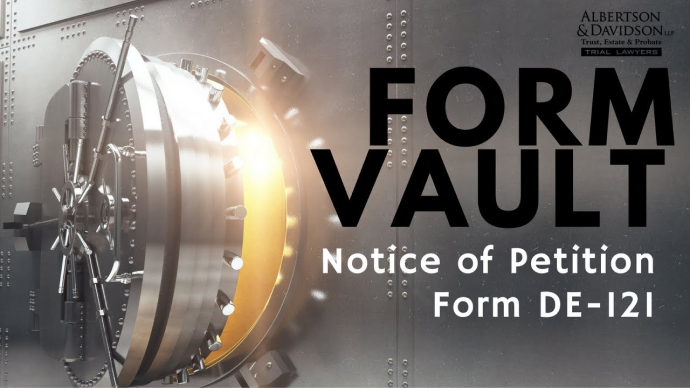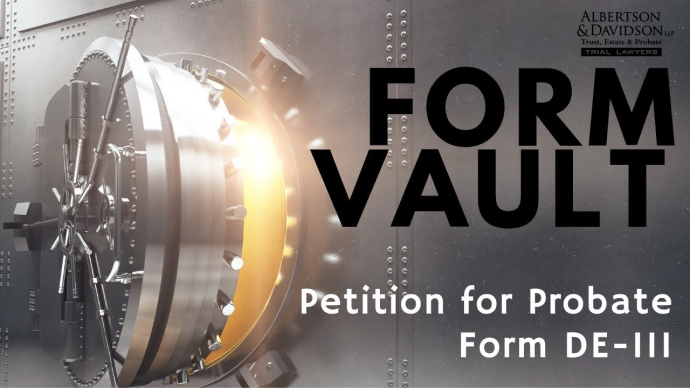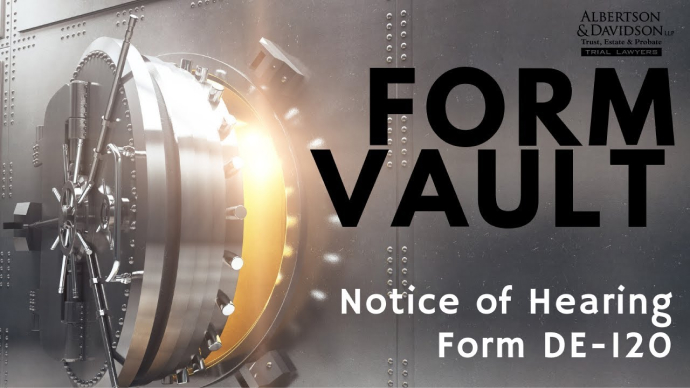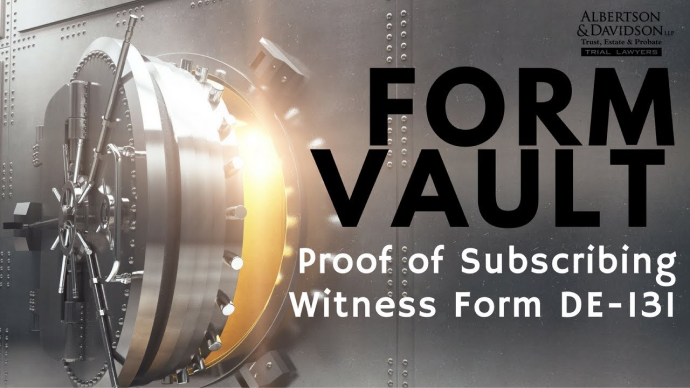Video Transcript
The following is an unedited, verbatim transcript of our video. It is not intended to be a stand-alone article.
Hi, this is Keith Davidson from Albertson & Davidson. In this video, we going to go over a Notice of Hearing for a Petition of Probate. This is going to be Form # DE-121.
In the previous video, I went over how to fill out the Petition for Probate which is DE-111. Now that you have your Petition for Probate, the next thing you need to do is provide proper notice to everybody who’s interested in the estate.
We’re going to start off here in Google and we just do a search for Judicial Council of California. We’ll go ahead and pull up the form so we want the court website. That is what this is here. We’re going to go to Select Category. All the forms we’re going to use for our Probate are going to be under Probate – Decedents Estates, and we’ll see the forms.
For this purpose, we’re going to want the form DE-121 which is our Notice of Petition to Administer the Estate. Here it is here. The form DE-121 is unique to a petition of probate. I have another video where I walked through a notice of hearing using DE-120. I said in that video that you use that notice of hearing for every purpose when you are giving notice of a hearing in a probate matter.
That’s true except for a petition of probate. When you are doing a petition for probate, you have to use this form because this form gives you some unique information that the other forms simply don’t include. So, the only time you are going to use a DE-121 is when you are filing a Petition for Probate to open a probate in California. So let’s go through how this works.
Page 1
At the top here, I put in my name and address. If you’re self-represented, you just put in your own name and your own address. Here I put in the client that I would be representing, Bob Smith, a made-up client. If you are representing yourself, you can either put Pro Per or you can just put your own name in there, Keith Davidson, Attorney for Keith Davidson. Everybody understands what that means.
We’re going to keep it, Bob Smith, for now. There we go. And we’re going to do the Estate of Rachel Smith, Bob’s wife, and this is where the notice begins. If you look at the DE-120, you can already see that this notice is very different, the layout of it. The information it provides is quite different. This is a notice of the petition to administer the Estate of. We’ve already said Estate of up there, but they want us to type it in again, and then the case number. By then, you should have the case number because you are going to give notice of the hearing date and you’re not going to get your hearing day until you file your petition for probate.
A lot of courts are going to want you to have this form filled out and they are going to want you to submit it to the court at the time you file your petition for probate so that the court can stamp in the date. Some courts want you to do that. Some don’t. What you should do is to have this form ready, take it with you to the courthouse. If you don’t need it, don’t worry about it. If you do need it, then you’ll have it. You are going to need it eventually because you are going to have to give notice to everybody. So we have our case number up here, and then it starts off by saying, “To all heirs, beneficiaries, creditors, contingent creditors,” everybody who might have an interest in the estate. They want to know to specify all names by which the decedent was known, and so we just have the one. But I guess if you have multiple names, you could put them here.
Petition for Probate
Then they’re giving notice that a Petition for Probate has been filed by, and they want the name of the person who filed that petition. In our case, it’s Bob Smith. They want to know in what court and in what county it was filed so everybody knows where to find this probate action if they want to appear and do something. So we are filing in Los Angeles County for this one, this is an example. If you are in San Mateo, Santa Clara, San Diego, Orange County, just type it in there.
The Petition for Probate requests that— this where you are going to put in the name of the person who you want to act as the personal representative. The personal representative is just an umbrella term that we use to describe both executors and administrators. An executor is somebody who is named in a will to manage the estate. An administrator is everybody else who is not mentioned in a will. If you have an estate with no will, then the person managing that estate is the administrator. They are all referred to as a personal representative. So in our Petition for Probate, we had asked that Bob Smith be appointed as the personal representative. He happens to be both the petitioner and the personal representative. They are not always the same. If Bob Smith was filing a petition trying to open a probate, but the will says somebody else is supposed to be the personal rep, then you would type in the other name right here. And that would be fine. That’s no big deal.
Number 4, the petition requests the decedent’s will and codicils, if any, be admitted to probate. If you have wills, then you are going to click number 4. If you are doing an intestate estate, meaning somebody who died without a will, then you don’t have to worry about number 4, because you are not asking that the will be admitted.
Independent Administration of Estate Act
Number 5, the petition requests authority to administer the estate under the Independent Administration of Estate Act. We talked a little about this in our petition for probate video. There’s an act. It’s quite long. Under Probate Code Section 10500, you can find all the particulars. What the act does, it allows the personal representative to take certain actions without seeking court approval first. It gives the executor a little bit more freedom.
There’s still a lot of things an executor can’t do without court approval like making distributions of the assets or paying themselves for a claim that they might have against the estate. But there’s a lot they can do. The law wants us to tell everybody in the world when we’re giving notice that we’re asking that the personal representative be given this independent power.
That’s something that is very important that you check if you are asking for it in your petition for probate. Now, if for some reason you are not asking for independent powers in your petition for probate, then you can just leave that blank. But do not make the mistake— I’ve made this mistake when I was early in my career, where I asked for independent powers for a petition but I didn’t check this box on the notice. The court simply won’t hear it. They’ll require you to reserve this notice and they’ll continue the hearing out, and it causes a delay in time. I learned very early on that these forms are important and these boxes are important. Make sure that you take them seriously. If you’re asking for that power, just go ahead and click that.
Now you have to fill in when is the first hearing going to be. The court will give you that. Let’s say that our hearing is on November 1. We’re going to go ahead and type on November 1. Let’s say it’s going to be at 9:30 and department 11. We don’t have a room number so we’ll just leave that blank. If there is a room number, then you’ll fill that out. And then they’ll want to know the address of the court. Most of the time, it’s going to be the same as noted above. I had already filled this in, but right here I have the street address and the mailing address of the Los Angeles downtown courthouse. If the addresses are different, you have to put in the right street address, mailing address. You can find these on the court’s website. So down here, all it’s asking is, Is that where’s the hearing going to be held or is it some other address of the court. Most of the time, it’s going to be the same as noted above and you just click that.
Now on number 7, it’s just giving everybody notice that if you object to the granting of this petition, you really need to appear and state your objection. If you don’t, then you’re going to waive your objection.
If you are a creditor or a contingent creditor of the decedent, then it’s telling you that you must file a claim with the court within this timeframe— four months from the date when letters are issued. We’re going to talk about Letters of Administration or Letters Testamentary in a separate video. But there is another document that you can see that you have to have in your petition. We’ll go through that. But number 8 is just giving creditors notice of what they have to do.
Number 9, you may examine the file kept in the court, and it talks about how to do that.
And then number 10, the petitioner or the attorney for the petitioner. You have to put in your name and address so that people will know how to contact you. If a creditor wants to file a creditor’s claim, they have to know where to mail that claim. So that’s why we’re going to put in this information. If you are representing yourself, no problem, you just put in your address where you get your mail so that you can get the creditor’s claims or any other objections that people might have. And you have to make sure to put in your telephone number so people can reach you there, and then you should be good to go.
Page 2
Page 2 here, the second part, this is the proof of service. So, this is where you’re going to be signing under penalty of perjury, that you took these actions. It’s important that you fill this out properly and that you actually do what this form says that you are going to do. First of all, you have to be over the age of 18 or else you can’t give notice. You have to be a resident or employed in the county where the mailing occurred. You can’t go to some county where you don’t work or live to mail it. You have to mail where you work or live. And then you have to put in your address. You can use your business address if you want people to notify you there. You can use your home address. I obviously would use my law firm’s address because that is where our mail goes to, and I’ll just put it in. In that way, people will know how to get hold of us.
Number 3, I served the foregoing Notice of Petition to Administer the Estate on each person named below by enclosing a copy in an envelope addressed as shown below and you either deposited it with the post office yourself or you put it to the mailing process at your work. A lot of businesses, corporations or big law firms, they have a mail department. You may not be the one who actually puts it into the post office or the post box or gives it to the mail person. But you put it within your mail system at work and you know that that mail system means that it will be mailed the same day with postage prepaid. You have to make sure you know that if you’re going to check box B. If you don’t know that, just deposit it in the mail yourself with postage fully prepaid. In that way, you know that you did exactly what you said you’re going to do. And then let’s put the date that we’re giving notice and the city and state where we mailed it. That is where we gave the notice from.
Number 5 is important. It says that along with this notice, you also sent a copy of the petition or other document referred to in the notice. The petition that is referred to in this notice is the petition for probate, from DE-111. You’re going to fill that out and file with the court anyway. We strongly recommend that you check number 5 and that you send a copy of that petition with this notice.
That way, people can’t complain later that they got the notice but didn’t get the petition. The court might continue the hearing to allow people to get a copy of the petition. Do yourself a favor and make it easy on everybody and easy on yourself primarily. Just check this box and send a copy of the petition for probate with this notice. You’ll be happy you did. It makes it real easy. Then you’re going to put the date that you signed this. It doesn’t necessarily have to be the same date that you mailed it. Some people shouldn’t be the same date as you mailed it. But most of the time it is because you’ll mail it and then you’ll sign this form.
Down below, you’re going to put the name and address of every person who’s entitled to notice. If you can’t fit it in with these six lines, you can continue on an attachment. We almost always use an attachment because it is easier to keep track of people that way. If you have it in a separate word document that you attach to this notice, then you can use that separate word document for other purposes in your probate. And you will need to serve it with various different forms so sometimes it is easier to use an attachment. I always type in See Attachment up here so just people know that we’re not just leaving it blank. It’s easy to miss this little checkbox down here. I just say See Attachment.
Now it’s important that you send this to everybody who’s entitled to notice. The people who are entitled to notice include everybody named in the Will. It doesn’t matter how they’re named. It doesn’t matter if they’re current or contingent beneficiaries. If you see a name in a will, it doesn’t matter even if they’re successors or executors, you give notice. Just send them notice. And then you also have to serve notice on all heirs at law, even if they’re not on the Will.
Let’s say a decedent has children and the children aren’t receiving anything under the will, you still have to give the children notice. Make sure you serve notice on everybody named in the will and everybody who’s an heir at law which would usually be a spouse and children. If somebody passes away and they don’t have a spouse and they don’t have children, then the heirs of the law might be the parents. If they don’t have a parent, then it’s going to be their brothers and sisters. Make sure that you include those people.
It’s way better to give too much notice than not enough notice. If you don’t give enough notice, the court can’t hear your petition and the court will never grant it. You’re better off over noticing, so make sure that you notice everybody.
In the end, you’re going to print this form. You can save it. Ultimately you’re going to file it with the court. The whole purpose of this form is to notify the court that you took the actions that you said you did under this form. This blank area up here, where it says for court use only, that’s where you’re going to take it to the court. The court’s going to stamp it and file it and then you will have proof that you gave proper notice to everybody. If you don’t have this form, DE-121, served and filed at the court by the time your hearing comes along, the court simply will not hear your petition because it can’t. It doesn’t have the power to hear your petition until proper notice is given. This form is crucially important. Make sure you fill it out, mail it out and file it and then you’ll be good to go.




